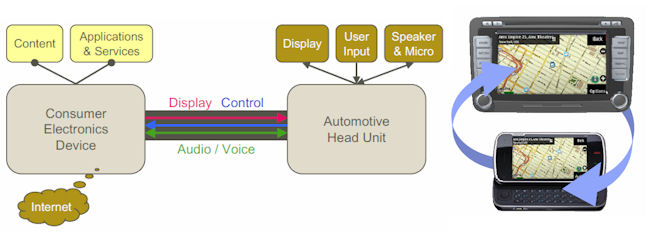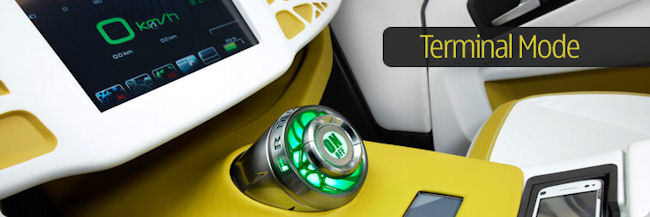Key points
- Terminal Mode is a standard that aims to enable the next generation of mobile device and car integration systems.
- Terminal Mode replicates a mobile device's screen on to an in-dash display (head unit); it also allows interaction from the head unit and associated controls to be sent back to the mobile device. This enables the display of, and interaction with, services and applications running on the phone.
- Terminal Mode consists of a set of basic protocols, enabling user-interface replications: VNC (display synchronisation), RTP and Bluetooth (audio) and UPnP (service discovery). It includes provision for driver distraction mechanisms (limiting access to features whilst driving).
- Terminal Mode is service and device agnostic (i.e. the aim is to become an industry standard and usable on all types of devices: Blackberry, Android, iPhone and so on). However, the early implementations are likely to come on Nokia's Symbian and MeeGo devices.
- Nokia and C4EA will set up a Terminal Mode industry consortium later this year.
- Nokia will support Terminal Mode in all of its smartphones from the first half of 2011 onwards.
- The first Terminal Mode devices will be after market accessories sometime in 2011, followed by in-car-integrated systems in late 2012.
Terminal Mode promotional video from Volkswagen and Nokia
Terminal Mode in detail
Terminal Mode, which originated as an NRC research project, goes far beyond current Bluetooth Audio (HSP, A2DP, AVRCP etc.) and SAP/rSAP (SIM Access Profile) based systems. It aims to offer deeper integration with multimedia capabilities and has display and input synchronization to enable the use of applications and other services on the phone. It also includes support for driver distraction features, i.e. what's OK to show while driving (e.g. Maps) and what's not (replying to a text messages).

In practice, what you'll see is replication of the phone's screen on a display embedded into, or attached to, the dashboard (known as the head unit); this may be accompanied by some additional controls on the side of the display and/or on the steering wheel of the car. Furthermore, the dashboard screen will replicate input back to the phone (i.e. touching the screen on the dashboard sends the touch back to the phone). This means you'll be able to fully interact with the phone from the dashboard display and controls, which means you'll be able to use existing applications such as Maps and Music.
One of the more intriguing possibilities is the idea that we may see applications specifically designed to be used in Terminal Mode. They could be modifications of existing applications or entirely new applications (e.g. automatic trip computers). A common change for existing applications would be to have a simplified user interface (e.g. fewer controls/bigger fonts) so as to be easy to use when driving along.
Having access to a full range of functionality has clear safety implications, which is recognised in Terminal Mode's driver distraction mechanisms. These include the obvious voice control and shortcut features, but also include the ability to define a set of rules (contextual data) about applications and services on the mobile device, classifying them as 'safe' or 'unsafe' to be used while driving. This information will be transmitted to the head unit, which will then filter the application as necessary. The head unit will only allow applications considered 'safe' to be displayed whilst the car is moving. The onus here will be on manufacturers to comply with local legal restrictions, so there will be regional variations.
In technical terms, Terminal Mode consists of a set of three basic protocols:
- VNC, for display synchronization and event input
- RTP (real time protocol) and BT (Bluetooth) for audio transport
- UPnP, for service negotiation
The key advantages of using VNC is that it removes the burden of keeping car systems up to date with the ever expanding portfolio of mobile devices. The integration happens at the software platform level, with VNC used to provide a single common device independent communications protocol. Here is a video from RealVNC, which gives some additional details on the VNC side of the technology. Terminal Mode also includes provision for scaling and resizing screen output/input, which means the resolution of the source device and head unit do not need to match, further burnishing the standard's device agnostic credentials.
RTP and Bluetooth will be the carriers for audio in Terminal Mode systems, in the same way they are now used in the majority of Bluetooth car kits. With greater device integration, audio goes beyond voice calls; playback of music, driving directions, Internet radio and alerts sounds will all come into play.
UPnP is used for service negotiation. This will tell a handset and head unit what the other's respective capabilities are. This recognises that there will be no fixed hardware requirements or standards and allows the system to be device agnostic.
Indeed device agnosticism is an overriding concern of Terminal Mode in general. It is specifically designed to be an industry standard and is therefore not limited to any one software platform or device manufacturer (compatibility pursuit). This reflects Nokia's corporate belief that the greatest value is achieved by creating open ecosystems; an attitude which largely comes from its experience in defining mobile telecoms standards. RealVNC already has examples of its VNC remote control for mobile devices running on Windows Mobile, Blackberry and Android and want to extend this to iOS when the necessary APIs become available.
Nokia devices and Terminal Mode in the market
Terminal Mode is currently in the final stages of its intial specifications. From the first half of 2011, Terminal Mode will be supported by all of Nokia's future smartphones (support on the handset side is relatively simple and will likely become a standard platform component).
Nokia also plan to continue to contribute to the development of Terminal Mode by contributing to future specifications developments and creating reference implementations (concept examples).
Nokia and CE4A intend to set up an Terminal Mode industry consortium, similar to the way Nokia helped found the NFC Forum. As part of this process, Nokia and CE4A have invited other manufacturers from both the mobile and automotive worlds to get involved. Those currently involved include Volkswagen, BMW, Audi, Porsche, Daimler, Fiat, Continental, Alpine, Harman Becker and Clarion. The industry consortium would take a role in shaping the future of the specification and would likely adopt responsibility for certification to ensure compatibility between respective devices.

N97 connected to a head unit in a concept installation
Going forward, the Terminal Mode 1.0 standard is expected to be published in August; subsequently, there will be up to two updates a year, with Terminal Mode 1.1 scheduled for Q1 2011.
The first Terminal Mode head units (car components) will be provided as aftermarket accessories (i.e. installed as accessories after purchasing a car, similar to many Bluetooth car kits). These are most likely to come from premium manufacturers such as Alpine, Denso or Pioneer, although no official manufacturer announcements about products have been made. Systems from car manufacturers themselves may take a little longer to appear, perhaps by the second half of 2012.
The success of Terminal Mode will obviously depend on the uptake by the various partners involved. The specification has been designed such that all parties should benefit, which is a good start, and to be device and service agnostic, allowing consumer choice, which might well be the key ingredient. You can draw a parallel with existing carphone systems; there are complete phone systems available (generally requiring an extra SIM), but the generic Bluetooth car kit, which can be used almost any existing phone is much more popular. Similarly the device agnostic Terminal Mode system would likely be more popular with consumers than standalone proprietary systems.
What about MeeGo Automotive UX?
MeeGo, which Nokia intends to use in its high-end 'mobile computers', has ambitions in the automotive space. In addition to its Tablet, Handet and Netbook UXs, the intention is to have an IVI UX (In Vehicle Infotainment). While we are unlikely to see devices from Nokia in this space, it does raise the questions of whether these two technologies would be contradictory. The answer is 'not necessarily', indeed a MeeGo Automotive-powered system system might include support for Terminal Mode to link a consumer's existing device.
Moreover, Terminal Mode is, currently, still relatively limited in scope. For example, it does not cover video and high end gaming for rear seat entertainment use cases, nor does it provide the mobile device with access to car data (and vice versa). Therefore it's possible to envision a system that combines both technologies. Something that might be considered a premium offering?
More information
More information on Terminal Mode is available on the Nokia website.
Rafe Blandford, 15 July 2010
